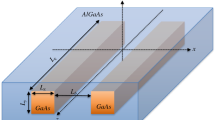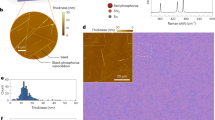Abstract
Semiconducting nanowires offer the possibility of nearly unlimited complex bottom-up design1,2, which allows for new device concepts3,4. However, essential parameters that determine the electronic quality of the wires, and which have not been controlled yet for the III–V compound semiconductors, are the wire crystal structure and the stacking fault density5. In addition, a significant feature would be to have a constant spacing between rotational twins in the wires such that a twinning superlattice is formed, as this is predicted to induce a direct bandgap in normally indirect bandgap semiconductors6,7, such as silicon and gallium phosphide. Optically active versions of these technologically relevant semiconductors could have a significant impact on the electronics8 and optics9 industry. Here we show first that we can control the crystal structure of indium phosphide (InP) nanowires by using impurity dopants. We have found that zinc decreases the activation barrier for two-dimensional nucleation growth of zinc-blende InP and therefore promotes crystallization of the InP nanowires in the zinc-blende, instead of the commonly found wurtzite, crystal structure10. More importantly, we then demonstrate that we can, once we have enforced the zinc-blende crystal structure, induce twinning superlattices with long-range order in InP nanowires. We can tune the spacing of the superlattices by changing the wire diameter and the zinc concentration, and we present a model based on the distortion of the catalyst droplet in response to the evolution of the cross-sectional shape of the nanowires to quantitatively explain the formation of the periodic twinning.
This is a preview of subscription content, access via your institution
Access options
Subscribe to this journal
Receive 51 print issues and online access
$199.00 per year
only $3.90 per issue
Buy this article
- Purchase on Springer Link
- Instant access to full article PDF
Prices may be subject to local taxes which are calculated during checkout





Similar content being viewed by others
References
Gudikson, M. S. et al. Growth of nanowire superlattice structures for nanoscale photonics and electronics. Nature 415, 617–620 (2002)
Dick, K. A. et al. Synthesis of branched ‘nanotrees’ by controlled seeding of multiple branching events. Nature Mater. 3, 380–384 (2004)
Hochbaum, A. I. et al. Enhanced thermoelectric performance of rough silicon nanowires. Nature 451, 163–168 (2008)
van Dam, J. A. et al. Supercurrent reversal in quantum dots. Nature 442, 667–670 (2006)
Bao, J. et al. Optical properties of rotationally twinned InP nanowire heterostructures. Nano Lett. 8, 836–841 (2008)
Ikonic, Z. et al. Electronic properties of twin boundaries and twinning superlattices in diamond-type and zinc-blende-type semiconductors. Phys. Rev. B 48, 17181–17193 (1993)
Ikonic, Z. et al. Optical properties of twinning superlattices in diamond-type and zinc-blende-type semiconductors. Phys. Rev. B 52, 14078–14085 (1995)
Lui, A. S. et al. Advances in silicon photonic devices for silicon based optoelectronic applications. Physica E 35, 223–228 (2006)
Krames, M. R. et al. Status and future of high-power light-emitting diodes for solid-state lighting. J. Display Tech. 3, 160–175 (2007)
Mattila, M. et al. Crystal-structure-dependent photoluminescence from InP nanowires. Nanotechnology 17, 1580–1583 (2006)
Hiruma, K. et al. Growth and optical properties of nanometer scale GaAs and InAs whiskers. J. Appl. Phys. 77, 447–462 (1995)
Johansson, J. et al. Structural properties of <111>B-oriented III–V nanowires. Nature Mater. 5, 574–580 (2006)
Xiong, Q. et al. Coherent twinning phenomena: Towards twinning superlattices in III–V semiconducting nanowires. Nano Lett. 6, 2736–2742 (2006)
Verheijen, M. A. et al. Three dimensional morphology of GaP-GaAs nanowires revealed by transmission electron microscopy tomography. Nano Lett. 7, 3051–3055 (2007)
Fissel, A. et al. Formation of twinning-superlattice regions by artificial stacking of Si layers. J. Cryst. Growth 290, 392–397 (2006)
Hibino, H. et al. Twinned epitaxial layers formed on Si(111) √3×√3-B. J. Vac. Sci. Technol. A 16, 1934–1937 (1998)
Hao, Y. et al. Periodically twinned nanowires and polytypic nanobelts of ZnS: The role of mass diffusion in vapor-liquid-solid growth. Nano Lett. 6, 1650–1655 (2006)
Akiyama, T. et al. An empirical potential approach to wurtzite-zinc-blende polytypism in group III–V semiconducting nanowires. Jpn. J. Appl. Phys. 45, L275–L278 (2006)
Glas, F. et al. Why does wurtzite form in nanowires of III–V zinc blende semiconductors? Phys. Rev. Lett. 99, 146101 (2007)
Minot, E. D. et al. Single quantum dot nanowire LEDs. Nano Lett. 7, 367–371 (2007)
Malina, V. et al. Effect of deposition parameters in the electrical and metallurgical properties of Au-Zn contacts to p-type InP. Semicond. Sci. Technol. 9, 1523–1528 (1994)
Weizer, G. W. et al. Au/Zn Contacts to ρ-InP: Electrical and Metallurgical Characteristics and the Relationship Between Them (NASA Technical Memorandum 106590, 1994)
Brakke, K. E. The surface evolver. Exp. Math. 1, 141–165 (1992)
Brakke, K. E. The Surface Evolver Version 2.30. 〈http://www.susqu.edu/brakke/evolver/evolver.html〉 (2008)
Ross, F. M. et al. Sawtooth faceting in silicon nanowires. Phys. Rev. Lett. 95, 146104 (2005)
Hurle, D. T. J. A mechanism for twin formation during Czochralski and encapsulated vertical Bridgman growth of III–V compound semiconductors. J. Cryst. Growth 147, 239–250 (1995)
Liu, Q. K. K. et al. Equilibrium shapes and energies of coherent strained InP islands. Phys. Rev. B 60, 17008 (1999)
Acknowledgements
This research was carried out under project number MC3.05243 in the framework of the strategic research programme of the Materials Innovation Institute (M2i), the former Netherlands Institute of Metals Research, the FP6 NODE (015783) project, the Ministry of Economic Affairs in the Netherlands (NanoNed) and the European Marie Curie programme. We thank H. de Barse and F. Holthuysen for SEM imaging and P. van der Sluis, H. Wondergem and M. Decré for discussions.
Author Contributions All authors contributed to the design of experiments. G.I. was responsible for MOVPE growth, and M.A.V. for the TEM experiments. R.E.A. and M.A.V. analysed the TEM data. L.-F.F. and W.J.P.v.E. analysed the data quantitatively. R.E.A., L.-F.F., W.J.P.v.E. and E.P.A.M.B. co-wrote the paper.
Author information
Authors and Affiliations
Corresponding author
Supplementary information
Supplementary Information
This file contains Supplementary Notes, Supplementary Figures S1-S4 with Legends and Supplementary References (PDF 487 kb)
Rights and permissions
About this article
Cite this article
Algra, R., Verheijen, M., Borgström, M. et al. Twinning superlattices in indium phosphide nanowires. Nature 456, 369–372 (2008). https://doi.org/10.1038/nature07570
Received:
Accepted:
Issue Date:
DOI: https://doi.org/10.1038/nature07570
This article is cited by
-
A library of polytypic copper-based quaternary sulfide nanocrystals enables efficient solar-to-hydrogen conversion
Nature Communications (2022)
-
Defect-driven selective metal oxidation at atomic scale
Nature Communications (2021)
-
Wurtzite AlGaAs Nanowires
Scientific Reports (2020)
-
Effects of Sulfur Doping on Generalized Stacking Fault Energy of Indium Phosphide
Electronic Materials Letters (2020)
-
Engineering the Side Facets of Vertical [100] Oriented InP Nanowires for Novel Radial Heterostructures
Nanoscale Research Letters (2019)
Comments
By submitting a comment you agree to abide by our Terms and Community Guidelines. If you find something abusive or that does not comply with our terms or guidelines please flag it as inappropriate.



